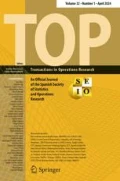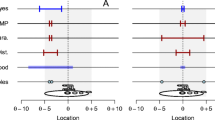Abstract
The effectiveness of the THESEUS multi-criteria sorting method is characterized, here, by (i) its capacity for suggesting precise and appropriate assignments; (ii) the probability of suggesting imprecise assignments; and (iii) the probability of suggesting incorrect assignments. We study how these important features are influenced by the number of criteria and categories, the cardinality of the reference set and the level of decision-maker consistency. We present a theoretical characterization and a wide range of experimental results that confirm and complement the formal analysis. The proposed way of analyzing effectiveness may be applied to other multi-criteria sorting methods.













Similar content being viewed by others
References
Almeida-Dias J, Figueira JR, Roy B (2010) Electre tri-c: a multiple criteria sorting method based on characteristic reference actions. Eur J Oper Res 204(3):565–580
Almeida-Dias J, Figueira JR, Roy B (2012) A multiple criteria sorting method where each category is characterized by several reference actions: the electre tri-nc method. Eur J Oper Res 217(3):567–579
Bouyssou D, Marchant T (2015) On the relations between electre tri-b and electre tri-c and on a new variant of electre tri-b. Eur J Oper Res 242(1):201–211
Brito AJ, de Almeida AT, Mota CM (2010) A multicriteria model for risk sorting of natural gas pipelines based on electre tri integrating utility theory. Eur J Oper Res 200(3):812–821
Butler J, Jia J, Dyer J (1997) Simulation techniques for the sensitivity analysis of multi-criteria decision models. Eur J Oper Res 103(3):531–546
Dimitras A, Zopounidis C, Hurson C (1995) A multicriteria decision aid method for the assessment of business failure risk. Found Comput Decis Sci 20(2):99–112
Doumpos M, Marinakis Y, Marinaki M, Zopounidis C (2009) An evolutionary approach to construction of outranking models for multicriteria classification: the case of the electre tri method. Eur J Oper Res 199(2):496–505
Doumpos M, Zopounidis C (2002) Multicriteria decision aid classification methods. Applied Optimization, vol 73. Kluwer Academic Publishers, Dordrecht, Boston, London
Fernandez E, Navarro J (2011) A new approach to multi-criteria sorting based on fuzzy outranking relations: the theseus method. Eur J Oper Res 213(2):405–413
Fernandez E, Navarro J, Bernal S (2009) Multicriteria sorting using a valued indifference relation under a preference disaggregation paradigm. Eur J Oper Res 198(2):602–609
Fernandez E, Navarro J, Duarte A, Ibarra G (2013) Core: a decision support system for regional competitiveness analysis based on multi-criteria sorting. Decis Support Syst 54(3):1417–1426
Fernandez E, Navarro J, Mazcorro G (2012) Evolutionary multi-objective optimization for inferring outranking model’s parameters under scarce reference information and effects of reinforced preference. Found Comput Decis Sci 37(3):163–197
Fernandez E, Navarro J, Salomon E (2014) Automatic enhancement of the reference set for multi-criteria sorting in the frame of theseus method. Found Comput Decis Sci 39(2):57–77
Figueira JR, Greco S, Roy B, Słowiński R (2010) ELECTRE methods: main features and recent developments. In: Zopounidis C, Pardalos PM (eds) Handbook of multicriteria analysis. Applied optimization, vol 103, pp 51–89. Springer, Heidelberg, Dordrecht, London, New York
Macary F, Dias JA, Figueira J, Roy B (2014) A multiple criteria decision analysis model based on electre tri-c for erosion risk assessment in agricultural areas. Environ Model Assess 19(3):221–242
Mailly D, Abi-Zeid I, Pepin S (2014) A multi-criteria classification approach for identifying favourable climates for tourism. J Multi Criteria Decis Anal 21(1–2):65–75
Mavrotas G, Diakoulaki D, Capros P (2003) Combined mcda-ip approach for project selection in the electricity market. Ann Oper Res 120(1–4):159–170
Mousseau V, Dias L (2004) Valued outranking relations in electre providing manageable disaggregation procedures. Eur J Oper Res 156(2):467–482
Nepomuceno LDdO, Costa HG (2015) Analyzing perceptions about the influence of a master course over the professional skills of its alumni: a multicriteria approach. Pesqui Oper 35(1):187–211
Norese MF, Carbone V (2014) An application of electre tri to support innovation. J Multi Criteria Decis Anal 21(1–2):77–93
Pereira D, Mota C, Miranda J (2013) Municipal human development index for brazilian cities based on electre tri-c. In: 2013 IEEE International Conference on Systems, Man, and Cybernetics (SMC), pp 736–740. IEEE
Roy B (1991) The outranking approach and the foundations of electre methods. Theory Decis 31(1):49–73
Roy B (2002) Présentation et interprétation de la méthode electre tri pour affecter des zones dans des catégories de risque. Document du LAMSADE 124
Siskos Y, Grigoroudis E, Krassadaki E, Matsatsinis N (2007) A multicriteria accreditation system for information technology skills and qualifications. Eur J Oper Res 182(2):867–885
The AN, Mousseau V (2002) Using assignment examples to infer category limits for the electre tri method. J Multi Criteria Decis Anal 11(1):29–43
Xidonas P, Mavrotas G, Psarras J (2009) A multicriteria methodology for equity selection using financial analysis. Comput Oper Res 36(12):3187–3203
Yu W (1992) Electre tri(aspects méthodologiques et manueld’utilisation). Document- Université de Paris-Dauphine,LAMSADE
Zopounidis C, Doumpos M (2002) Multi-criteria decision aid in financial decision making: methodologies and literature review. J Multi Criteria Decis Anal 11(4–5):167–186
Acknowledgments
We acknowledge the support from CONACYT Project No. 236154. We also thank the anonymous reviewers for their helpful remarks.
Author information
Authors and Affiliations
Corresponding author
Appendix
Appendix
1.1 Deriving Equations (14) and (15)
Suppose that \(k'<k^{*}\).
Equations (12) and (13) can be arranged as:
Then,
or
Grouping both sums, we obtain Eq. (14).
If \(k'>k^{*}\), Eqs. (12) and (13) can be arranged as:
or
Equation (15) comes from grouping both sums.
Rights and permissions
About this article
Cite this article
Fernandez, E., Navarro, J., Covantes, E. et al. Analysis of the effectiveness of the theseus multi-criteria sorting method: theoretical remarks and experimental evidence. TOP 25, 314–339 (2017). https://doi.org/10.1007/s11750-016-0433-0
Received:
Accepted:
Published:
Issue Date:
DOI: https://doi.org/10.1007/s11750-016-0433-0




